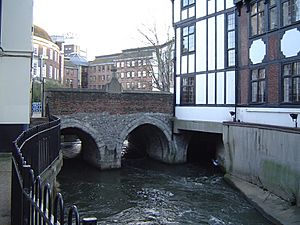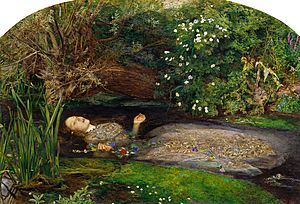Hogsmill River facts for kids
Quick facts for kids Hogsmill |
|
|---|---|

The Hogsmill at Kingston as it flows into the Thames
|
|
|
Location of the mouth in Greater London
|
|
| Country | England |
| Counties | Surrey, Greater London |
| Districts / Boroughs | Epsom and Ewell, Royal Borough of Kingston upon Thames |
| Towns | Ewell, Old Malden, Berrylands, Kingston upon Thames |
| Physical characteristics | |
| Main source | Bourne Hall Park Ewell, Surrey 51°21′01″N 0°15′03″W / 51.350313°N 0.250945°W |
| River mouth | River Thames Kingston upon Thames 51°24′33″N 0°18′30″W / 51.40917°N 0.30833°W |
| Length | 9.9 km (6.2 mi) |
| Discharge (location 2) |
|
| Basin features | |
| Progression | Hogsmill, Thames, North Sea |
| Basin size | 73 km2 (28 sq mi) |
| Tributaries |
|
The Hogsmill River is a small river in Surrey and Greater London, England. It's a type of river called a chalk stream, which means it flows over chalk bedrock. The Hogsmill starts in Ewell and flows into the River Thames at Kingston upon Thames. This meeting point is just before the Teddington lock, which is the lowest part of the Thames that isn't affected by tides.
The river is about 6 miles (9.9 km) long. Its catchment area (the land where all the water drains into the river) is about 73 square kilometers. In the past, the land near the river was often flooded. Now, much of it has been developed into sports fields, green spaces, and even a sewage treatment plant. The river is home to many different animals, fish, and insects.
One of England's oldest road bridges, the 12th-century Clattern Bridge, crosses the Hogsmill in Kingston. Also, the Coronation Stone, which is now near the river in Kingston, is thought to have been used to crown Saxon kings way back in the 900s!
The Hogsmill River has five smaller streams that flow into it. These are the Green Lanes Stream, Ewell Court Stream, Horton Stream, Bonesgate Stream, and Tolworth Brook.
Contents
Journey of the Hogsmill River
Through Epsom and Ewell
The Hogsmill River begins as a spring (a natural flow of water from the ground) just outside Bourne Hall Park in Ewell, Surrey. It flows north between Kingston Road and a sports field. Along its path, the river passes the sites of old mills, where gunpowder was made in the 1700s and 1800s.
The river then gently turns left and goes under the Mole Valley railway line. This is where the Hogsmill Open Space begins, a green area that follows the river until it reaches the border with Kingston.
The river continues through green spaces, passing between homes in Ewell Court and West Ewell. It is joined by the Green Lanes Stream. Further along, it flows between Poole Road Recreation Ground and Ewell Court Park. The Ewell Court Stream also joins the Hogsmill here, just after flowing out of Ewell Court Lake.
The river keeps flowing through open areas, passing schools and churches. It goes under Ruxley Farm Bridge, which was once a popular spot called the Ruxley Splash. The Bonesgate Stream then joins the Hogsmill. This meeting point marks the boundary between Epsom and Ewell in Surrey and Kingston in Greater London. After this, the Hogsmill turns right and continues to form the boundary near the A240 (Kingston Road).
Through Kingston
The river flows next to Worcester Park Road and Old Malden Lane, passing by sports grounds. It then enters a wooded area on the edge of Old Malden. The Hogsmill crosses the Chessington railway line near Malden Manor railway station. It then flows in a north-northwest direction, crossing the A3 road between Tolworth and Malden.
The river separates New Malden and Berrylands, flowing past sports fields. Here, the Tolworth Brook joins the Hogsmill. The river then goes under the South Western main railway line near Berrylands railway station. After leaving the green areas, the Hogsmill passes Kingsmeadow, Kingston Cemetery, and a sewage treatment plant on the eastern side of Kingston upon Thames.
The river flows under Villiers Road and past a campus of Kingston University. It also goes under the A307 (Wheatfield Way) near Kingston College. Finally, the Hogsmill River flows under Kingston High Street and Wadbrook Street. It meets the Thames right next to a restaurant and shops, just upstream from Kingston Bridge.
Streams Joining the Hogsmill
Green Lanes Stream
The Green Lanes Stream is about 2.1 miles (3.4 km) long. It starts from Stamford Green Pond on the eastern edge of Epsom Common. Other small streams from the common join it as it goes underground. It flows near Manor Green Road, sometimes above ground and sometimes hidden. It goes under Epsom Primary School before coming back above ground.
The stream runs next to Longmead Road, passing industrial estates and Blenheim High School. It then goes under the B2200 (Chessington Road) and flows between two roads also called Green Lanes. Finally, it enters the Hogsmill Open Space before joining the Hogsmill River.
Ewell Court Stream
The Ewell Court Stream is about 1.7 miles (2.7 km) long. It starts near a pond on the edge of Nonsuch Park by the A24 (London Road) in Stoneleigh. After going under the A24, it continues under Briarwood Road. You can see it briefly near Stoneleigh railway station.
The stream bends left under Stoneleigh Park Road and then under Walsingham Gardens and the A240 (Kingston Road). It then enters Ewell Court. After passing Preston Drive, it flows above ground through Ewell Court Park and into Ewell Court Lake. As it continues towards the Hogsmill, it passes the Packhorse Bridge. This bridge was named after the mules that carried gunpowder from the nearby mills.
Bonesgate Stream
The Bonesgate Stream is the main stream that feeds the Hogsmill River. It is 3 miles (5 km) long and starts in Malden Rushett. It flows northeast through farmlands and then just east of Chessington. After going under Filby Road, it passes The Bonesgate, a pub in Moor Lane.
The stream then flows through open spaces, going under a bridge near Cox Lane Community Centre. It passes the edge of the Cox Lane Estate before joining the Hogsmill by Tolworth Court Bridge under the A240 Kingston Road. From The Bonesgate Pub to Tolworth Court Bridge, this stream forms the boundary between West Ewell (Surrey) and Chessington (Greater London).
Horton Stream
The Horton Stream starts in the middle of Horton Country Park, Epsom. It is 3.3 miles (5.3 km) long and begins near West Park Hospital. The stream flows next to Horton Lane, passing West Park Farm and Horton Park Farm. After going through Horton Country Park, it flows through Horton Golf Course.
It then crosses Chessington Road in West Ewell and runs alongside Chessington Close. It continues through the playing fields of Epsom and Ewell High School and behind Scotts Farm Road. The Horton Stream then joins the Hogsmill near Ruxley Lane, after flowing under Scotts Farm Road.
Tolworth Brook
At 3.75 miles (6 km), Tolworth Brook (also called Surbiton Stream) is the longest stream that joins the Hogsmill. It starts on the edge of Claygate from springs at Grapesome Wood. It flows under the A3 road and then north past Lovelace Primary School.
It continues through rugby playing fields and crosses the A309 Esher bypass. It then passes west of Gladstone and Brook Roads through more playing fields. Parts of it are covered by pipes (culverted) as it flows through residential areas. The brook reappears north of a pub called The Oak on Ewell Road. It follows the back of Beaconsfield Road and goes under King Charles Road. It then reappears in Alexandra Recreation Ground and flows northeast through Edith Gardens Nature Reserve. Finally, it goes under Elmbridge Avenue to meet the Hogsmill.
Water Quality of the Hogsmill
The Environment Agency checks the water quality of rivers in England. They give each river an overall "ecological status," which can be high, good, moderate, poor, or bad. This status is based on things like the number and types of invertebrates (like insects), plants, and fish living in the river. They also check the "chemical status" by comparing chemical levels to safe limits. Chemical status is either good or fail.
In 2019, the Hogsmill's water quality was:
| Section | Ecological Status |
Chemical Status |
Overall Status |
Length | Catchment | Channel |
|---|---|---|---|---|---|---|
| Hogsmill | Moderate | Fail | Moderate | 9.908 km (6.157 mi) | 72.636 km2 (28.045 sq mi) | Heavily modified |
This table shows that in 2019, the Hogsmill had a "moderate" ecological status and "fail" for chemical status. This means there's still work to be done to make the river healthier.
Flooding Along the Hogsmill
In January 2014, during a very wet winter, the Hogsmill River overflowed its banks. This happened near Bourne Hall in Ewell Village and close to the B2200 London Road. The overflowing water spilled onto nearby roads and flooded many buildings with basements in the center of Ewell. The path along Kingston Road, just downstream from Bourne Hall, was also flooded.
The Hogsmill in Art
The Hogsmill River has been featured in famous paintings!
- Artist John Millais painted his famous work Ophelia with the landscape background inspired by the Hogsmill near Ewell.
- William Holman Hunt painted The Hireling Shepherd in the meadows by the Hogsmill.
- The doorway in Hunt's painting The Light of the World is thought to be part of an old gunpowder mill located on the Hogsmill at Ewell.
Industry Along the River
For many years, the Hogsmill River's water power was used to run watermills. Near Ewell Court, these mills were used to make gunpowder. This continued even after the Napoleonic Wars, helping to supply the American Civil War. However, the mills closed in 1875 because they couldn't meet new safety rules. Later, one of the old mill buildings was used to generate electricity for Ewell Court House.
There were also two flour mills in Ewell, called the Upper and Lower mills. At one point, they were also used for making paper. It's said that the Lower Mill provided flour for Queen Victoria's bakers! The Upper Mill was the last working corn mill on the river, still grinding corn in 1951. Today, it's the headquarters for the Samaritans charity.
Another group of gunpowder mills was set up at Worcester Park in 1720. These were known by different names like Malden Mills or Tolworth Mills. They finally closed in the 1860s.
Kingston had three mills: Chapel Mill (or the Old Mill), Middle Mill, and Hogg's Mill (or New Mill). All three were originally used for grinding corn. Later, Middle Mill processed coconut fibers, and Chapel Mill crushed coconut kernels to make oil. Hogg's Mill became a factory for metal polish. All these mills have been taken down, but the Old Mill House still stands and is a listed building (meaning it's protected because of its historical importance).
Local Legend
There's a story that William the Conqueror (a famous king who invaded England in 1066) "watered his horse" in the source waters of the Hogsmill. This is traditionally believed to have happened at the pool in Bourne Hall Park.





